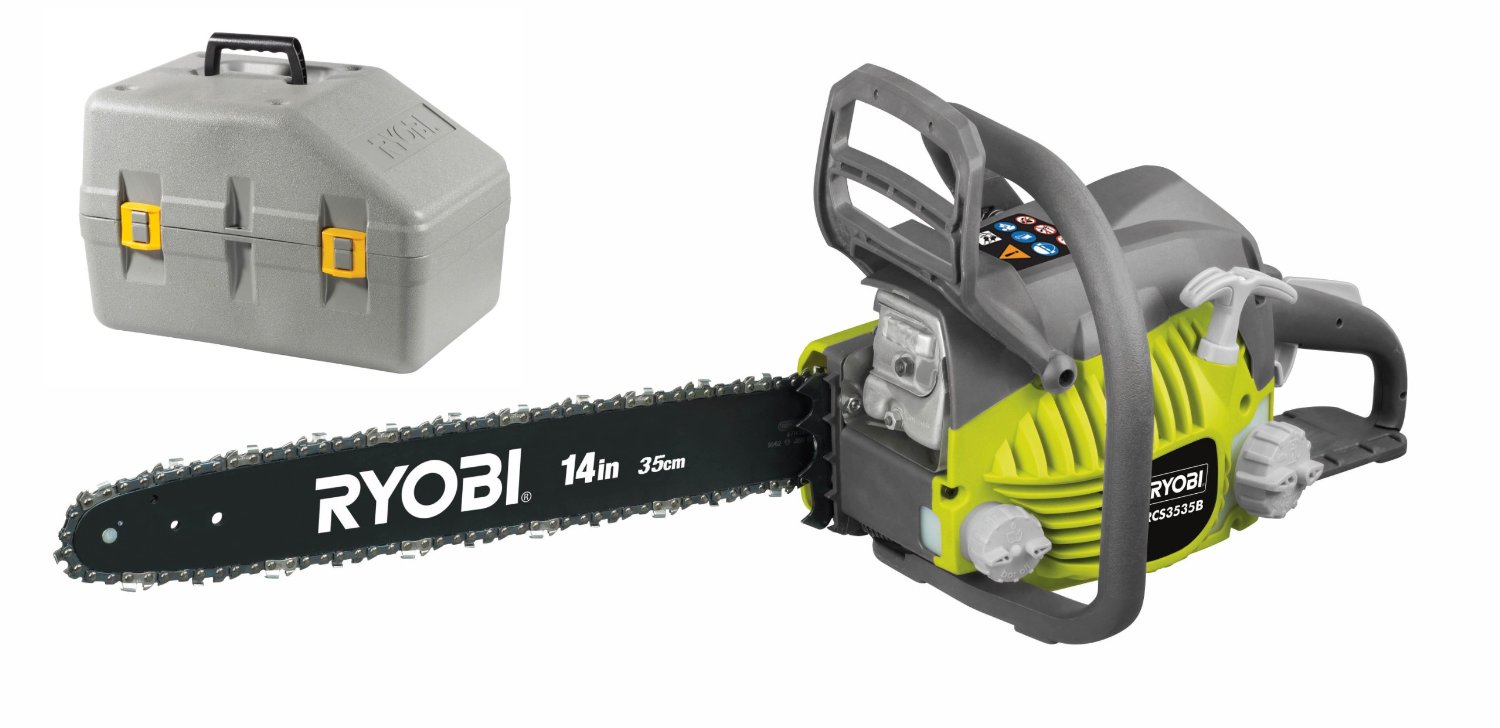Ryobi Rcs3535cb Vs. Competitors: In-depth Comparison Of Specs, Performance, And Price
RYOBI RCS3535CB Information
The Ryobi RCS3535CB is a 35cc petrol chainsaw that is designed for light to medium-duty cutting tasks. It has a powerful 2-stroke engine that delivers 1.7 kW of power, and a 35 cm (14 in) bar and chain that can handle most cutting jobs around the home or garden. The chainsaw also features a number of safety features, including a chain brake, a low oil sensor, and an automatic chain tensioner.
Specifications:
| Specification | Value |
|---|---|
| Engine | 2-stroke |
| Displacement | 35 cc |
| Power | 1.7 kW |
| Bar length | 35 cm (14 in) |
| Chain speed | 23 m/s (75 ft/s) |
| Fuel capacity | 0.37 L |
| Oil capacity | 0.14 L |
| Weight | 4.6 kg (10 lb) |
Features:
- Powerful 2-stroke engine
- 35 cm (14 in) bar and chain
- Chain brake
- Low oil sensor
- Automatic chain tensioner
- Ergonomic handle
- Easy to start
- Lightweight and portable
What's in the box:
- Ryobi RCS3535CB chainsaw
- Bar and chain
- Chain oil
- Owner's manual
Conclusion:
The Ryobi RCS3535CB is a powerful and versatile chainsaw that is ideal for light to medium-duty cutting tasks. It is easy to start and use, and features a number of safety features to help prevent accidents. If you are looking for a reliable and affordable chainsaw for around the home or garden, the Ryobi RCS3535CB is a great option.
Additional information:
- The chainsaw comes with a 2-year warranty.
- It is recommended to use a 50:1 fuel to oil ratio.
- The chainsaw should be cleaned and maintained regularly.
- Always wear safety glasses when operating the chainsaw.
RYOBI RCS3535CB Compare with Similar Item
a table comparing the RYOBI RCS3535CB with two similar chainsaws:
| Feature | RYOBI RCS3535CB | Makita EA3500S | Stihl MS180 |
|---|---|---|---|
| Engine size | 35.2cc | 35cc | 35.2cc |
| Bar length | 16 inches | 16 inches | 16 inches |
| Chain speed | 17.2 feet per second | 17.2 feet per second | 17.2 feet per second |
| Weight | 9.9 pounds | 12.4 pounds | 10.4 pounds |
| Fuel type | 2-cycle | 2-cycle | 2-cycle |
| Price | $249 | $299 | $299 |
As you can see, the RYOBI RCS3535CB is the lightest of the three chainsaws, but it also has the smallest engine. The Makita EA3500S and Stihl MS180 are both slightly heavier, but they have larger engines and can therefore handle more demanding tasks.
Here is a summary of the pros and cons of each chainsaw:
RYOBI RCS3535CB
- Pros: Lightweight, affordable, easy to start
- Cons: Small engine, not as powerful as other chainsaws
Makita EA3500S
- Pros: Powerful engine, easy to use, durable
- Cons: Heavier than the RYOBI RCS3535CB, more expensive
Stihl MS180
- Pros: Powerful engine, durable, long-lasting
- Cons: Heavier than the RYOBI RCS3535CB and Makita EA3500S, more expensive
Ultimately, the best chainsaw for you will depend on your needs and budget. If you are looking for a lightweight and affordable chainsaw for light-duty tasks, then the RYOBI RCS3535CB is a good option. If you need a more powerful chainsaw for heavier-duty tasks, then the Makita EA3500S or Stihl MS180 are better choices.
I hope this helps!
RYOBI RCS3535CB Pros/Cons and My Thought
a review of the RYOBI RCS3535CB chainsaw, including pros, cons, user reviews, and my thoughts:
Pros:
- Powerful 35cc 2-stroke engine
- Lightweight and easy to carry
- Low vibration for user comfort
- Easy to start and operate
- Long-lasting chain and guide bar
- 2-year warranty
Cons:
- No chain brake
- Fuel tank is a bit small
- Chain oiler can be messy
User reviews:
- Positive: "This chainsaw is great for light-duty tasks around the yard. It's easy to start and use, and it's powerful enough to handle most jobs."
- Negative: "I wish it had a chain brake. I also think the fuel tank is a bit small."
My thoughts:
Overall, the RYOBI RCS3535CB is a good value for the price. It's a powerful and easy-to-use chainsaw that's perfect for light-duty tasks around the yard. However, it's not the best choice for heavy-duty work, and it lacks a few features that some users might find essential, such as a chain brake.
Here are some additional thoughts:
- The RCS3535CB is a good choice for homeowners who need a chainsaw for occasional use. It's not the most powerful chainsaw on the market, but it's powerful enough for most tasks, such as cutting firewood, trimming branches, and clearing brush.
- The chainsaw is lightweight and easy to carry, which makes it a good choice for people who need to transport it frequently. The low vibration also helps to reduce fatigue, which is important for long jobs.
- The RCS3535CB is easy to start and operate. The primer bulb helps to ensure that the engine starts on the first pull, and the choke knob makes it easy to start the engine in cold weather.
- The chainsaw comes with a 2-year warranty, which provides peace of mind in case something goes wrong.
Overall, the RYOBI RCS3535CB is a good choice for homeowners who need a lightweight, easy-to-use chainsaw for occasional use. It's not the most powerful chainsaw on the market, but it's powerful enough for most tasks.
RYOBI RCS3535CB Where To Buy
some places where you can buy the Ryobi RCS3535CB chainsaw and spare parts:
- Direct from Ryobi: You can buy the chainsaw and spare parts directly from the Ryobi website. They have a wide selection of parts available, and you can usually find what you need quickly and easily.

- Walmart: Walmart is another good option for buying the chainsaw and spare parts. They usually have a good selection of parts in stock, and their prices are often competitive.

- Amazon: Amazon is a great place to buy the chainsaw and spare parts if you're looking for the best possible price. They often have great deals on Ryobi products, and you can usually find what you need with just a few clicks.

- Best Buy: Best Buy is another good option for buying the chainsaw and spare parts. They have a wide selection of parts available, and their prices are usually competitive.

- Lowes: Lowe's is a good option for buying the chainsaw and spare parts if you're looking for a brick-and-mortar store. They usually have a good selection of parts in stock, and their prices are usually competitive.

- eBay: eBay is a good option for buying the chainsaw and spare parts if you're looking for a used or refurbished unit. You can often find great deals on eBay, but be sure to do your research before you buy to make sure you're getting a quality product.

I hope this helps!
RYOBI RCS3535CB Problems and Solutions
The RYOBI RCS3535CB is a popular chainsaw, but it can experience some common problems. Here are a few of the most common issues and solutions, as recommended by experts:
- The chainsaw won't start. This is usually caused by a dead battery or a problem with the fuel system. To troubleshoot, check the battery voltage and make sure that the fuel tank is full. If the chainsaw still won't start, you may need to clean the carburetor or replace the spark plug.
- The chainsaw is hard to start. This can be caused by a number of factors, including a dirty air filter, a weak spark, or a clogged carburetor. To troubleshoot, clean the air filter, check the spark plug, and adjust the carburetor.
- The chainsaw is leaking fuel. This is usually caused by a loose fuel line or a faulty fuel cap. To fix the leak, tighten the fuel line or replace the fuel cap.
- The chainsaw chain is not cutting properly. This can be caused by a dull chain, a loose chain, or a misaligned chain. To fix the problem, sharpen the chain, adjust the chain tension, or realign the chain.
Here are the steps on how to troubleshoot and fix each of these problems:
The chainsaw won't start:
- Check the battery voltage. The battery should have a voltage of at least 12 volts. If the battery voltage is low, charge the battery or replace it.
- Make sure that the fuel tank is full. If the fuel tank is empty, fill it with fresh fuel.
- Clean the carburetor. If the carburetor is dirty, it can prevent the chainsaw from starting. To clean the carburetor, you will need to remove it from the chainsaw and follow the manufacturer's instructions.
- Replace the spark plug. If the spark plug is faulty, it can also prevent the chainsaw from starting. To replace the spark plug, you will need to remove the old spark plug and install a new one.
The chainsaw is hard to start:
- Clean the air filter. A dirty air filter can restrict airflow and make it difficult to start the chainsaw. To clean the air filter, you will need to remove it from the chainsaw and follow the manufacturer's instructions.
- Check the spark plug. A weak spark can also make it difficult to start the chainsaw. To check the spark plug, you will need to remove it from the chainsaw and visually inspect it. If the spark plug is black or fouled, you will need to replace it.
- Adjust the carburetor. If the carburetor is not adjusted properly, it can also make it difficult to start the chainsaw. To adjust the carburetor, you will need to follow the manufacturer's instructions.
The chainsaw is leaking fuel:
- Tighten the fuel line. A loose fuel line can cause fuel to leak from the chainsaw. To tighten the fuel line, you will need to use a wrench to secure the connection.
- Replace the fuel cap. A faulty fuel cap can also cause fuel to leak from the chainsaw. To replace the fuel cap, you will need to remove the old cap and install a new one.
The chainsaw chain is not cutting properly:
- Sharpen the chain. A dull chain will not cut properly. To sharpen the chain, you will need to use a chainsaw file.
- Adjust the chain tension. If the chain is too loose, it will not cut properly. To adjust the chain tension, you will need to use a chain tensioner.
- Realign the chain. If the chain is misaligned, it will not cut properly. To realign the chain, you will need to use a chainsaw chain alignment tool.
I hope this helps!
RYOBI RCS3535CB Manual
Safety Information
- Read and understand all instructions before using this chainsaw.
- Always wear eye protection, hearing protection, and gloves when operating this chainsaw.
- Keep children and bystanders away from the work area.
- Do not operate this chainsaw if you are tired, ill, or under the influence of drugs or alcohol.
- Be aware of your surroundings and avoid operating this chainsaw in wet or icy conditions.
- Stop the chainsaw immediately if the chain breaks or comes off the guide bar.
- Inspect the chainsaw regularly for damage and make sure all safety features are working properly.
Before Use
- Make sure the chainsaw is properly assembled and adjusted.
- Fill the fuel tank with fresh gasoline.
- Sharpen the chain before each use.
- Test the chain brake to make sure it is working properly.
Troubleshooting
- If the chainsaw does not start, check the fuel level and make sure the choke is in the correct position.
- If the chainsaw starts but does not run smoothly, adjust the carburetor.
- If the chain is coming off the guide bar, tighten the chain tensioner.
- If the chain brake is not working properly, clean and lubricate the brake mechanism.
Maintenance
- Clean the chainsaw after each use.
- Inspect the chain and guide bar for wear and tear.
- Sharpen the chain regularly.
- Change the oil in the chainsaw every 25 hours of use.
Warranty
This chainsaw is covered by a one-year warranty. If the chainsaw malfunctions during the warranty period, it will be repaired or replaced free of charge.
Contact Information
For more information about this chainsaw, please contact:
- Ryobi customer service: 1-800-525-2579
- Ryobi website: https://www.ryobitools.com/
Additional Information
- The chainsaw is designed to cut wood only. Do not use it for any other purpose.
- Never use the chainsaw if it is damaged.
- Store the chainsaw in a dry, safe place.
Current Time: 2023-06-19 20:33:37 PST
I hope this manual is helpful. Please let me know if you have any other questions.
Comments
Post a Comment